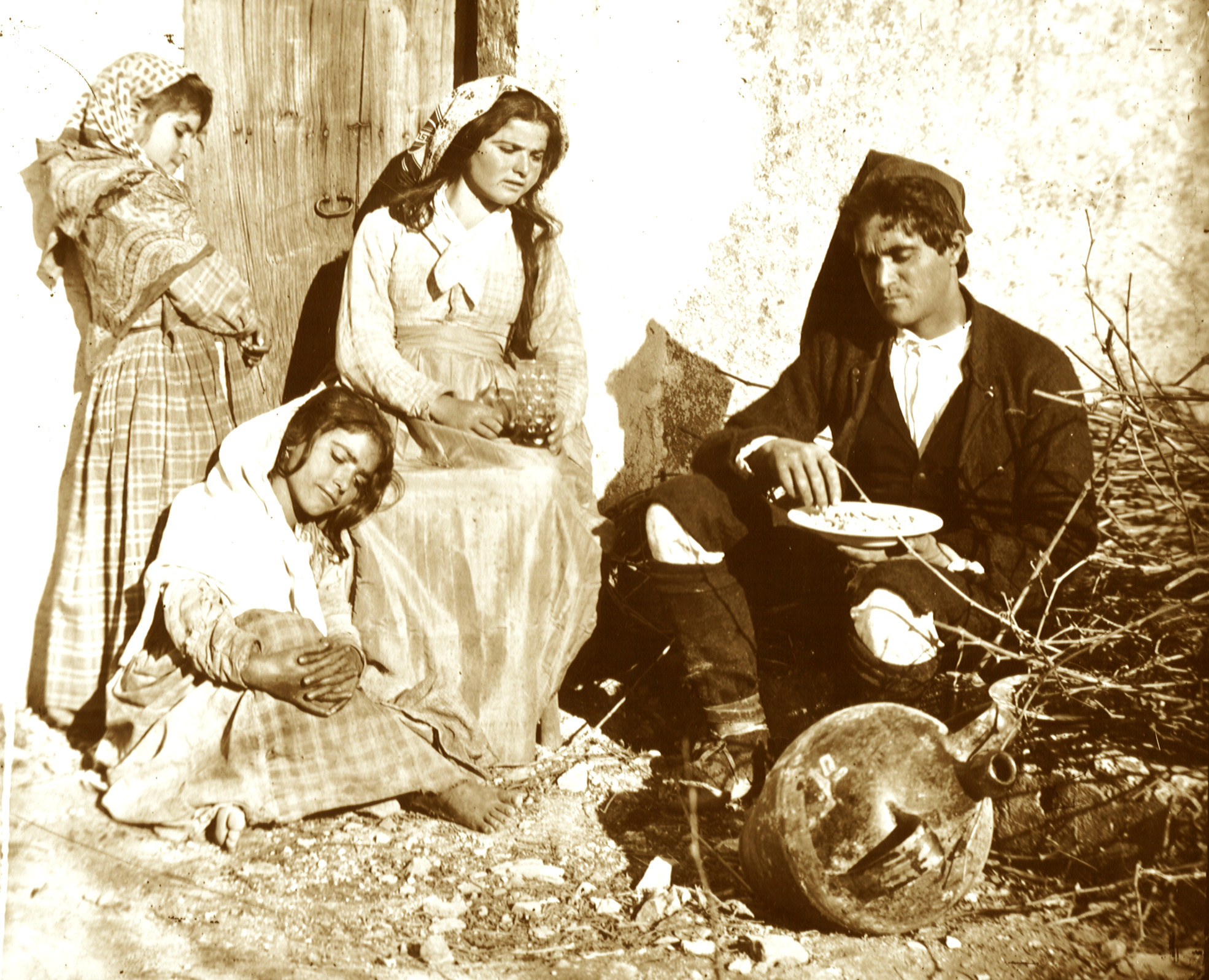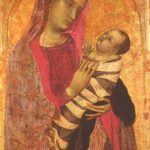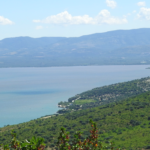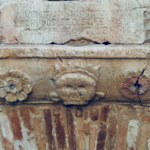
Earthquakes – La Terra Trema

Italy’s changeable landscape is as much a character in her history as the people who live within her. Repeatedly, earthquakes are written into that history. Yet Italy often appears as a garden of Eden, full endlessly of the good things of the Earth: ancient olive groves, vines, fields of wheat, and much more; a bounty elicited by human industry and knowledge over many generations. Even the most apparently barren and uncultivated rocky slope may abound with edible plants and herbs of all kinds. From the sea, fishers still harvest. Everywhere potable water springs from Italy’s permeable limestone.
This gentle and generous Mother Earth is at times savage. For Italy lies along fault lines deep in the Earth. From time to time volcanoes like Vesuvius will rain down destruction. Yet when the Earth shakes (as she does often) in a moment, all can disappear: public edifices of great beauty, ancient works of art, innumerable homes, entire families and communities and life itself. All erased.
The accounts of such events are intensely human. The frailty of human beings, and their shared fate, laid bare in the face of such overwhelming destructive power.
The Great Earthquake of 1627
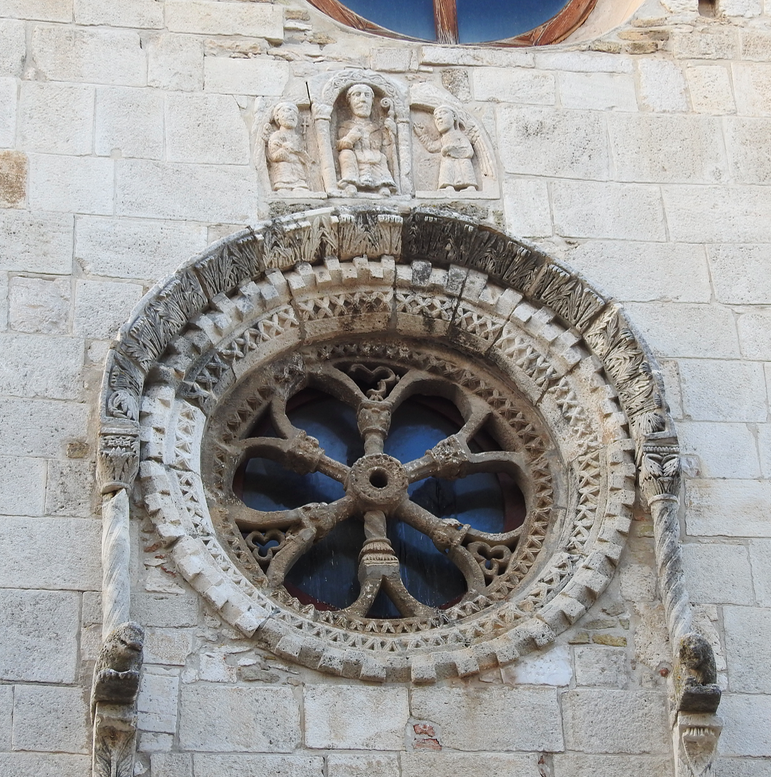
The earthquake described in the sources as the “Great Earthquake of 1627” struck the area which is now the province of Foggia. Antonio Lucchino in the city of San Severo was working in his grove when the earthquake struck. It was the height of summer. At this time of year in this part of Italy, the afternoon heat is so unbearable that the streets are deserted and virtually everyone is enclosed in their homes. In 1627 their homes became tombs.
For four days before the earthquake the air was very still : there was not even the slightest breath of wind. The heat was extreme and almost unbearable. …
On Friday 30th of July of the year 1627 the sun blazed down with a great heat, as it had on the days before. The day was still … some were closed in their homes, and others in cool places, and many had taken shade from the sun along the streets where the buildings provided it. All sought relief from the oppressive heat. Myself, having matters to attend to, had gone to my orchard near the square of the Church of the Graces (Chiesa alle Grazia), where there were also ten others with me.
The fateful hour came upon is. It was four of the afternoon. A great roar or bellow came from the Earth. Not like the bellow of a bull, but a vast loudness that has no possible comparison. It filled both mind and ear. Immediately afterwards the earth moved like the waves of the sea: the greatest waves that might be seen at sea. The movement was such that I and my companions were thrown face-down on the ground. Without the roar diminishing in the slightest, a new wave passed over us, and again we fell. A third wave struck, but with such a force that it seemed to me as if I was falling from a high hill. The ground then gave a great and terrible shake to the rear and immediately the city was reduced to ruins. We heard and saw the Chiesa alle Grazie fall before our eyes. A gentle tremor followed, and standing up, we who survived, saw the entire city covered over with a dense and dark dust. And thus also were San Paolo, Serra Capriola, Apricena and Lesina.
Reeling and full of fears, all of us rushed towards the city to help, if we could, our relatives and compatriots. The tremors continued until we reached the city, which was almost a stadia distant. Then the wind began to rise lifting dust into the air, obscuring the sun, which seemed distant and as if wrapped in tongues of flame. The ruin of our poor city was plain to see: fallen and smashed into rubble.
Soon our sad eyes saw scenes that moved us to pity and compassion. The lamentations of survivors were heard from every direction, mourning both the personal and communal tragedy. Approaching us from the city we saw figures so covered in dust that it was not possible to say whether they were human. Each of them seemed a mass of dust. The anguish of the scene was heightened by the sight of the injuries on these suffering victims: blood ran down their faces, which passing through the dust, seemed like so many rivulets running through a field. Others could be seen carrying out the dead. Others were only half alive. Yet others were maimed, unable to walk, and they laid them down in the fields with heartrending tears and lamentations. Only a heart of stone could not join in their sorrow and lamentation.
Those who had survived unscathed helped raise tents in the orchards made from salvaged pieces of canvas and bed-sheets (which with some effort had been found). Meanwhile we entered the city, where continuing cries and lamentation could be heard. One mourner had lost a father. Another a mother. Others children or brothers and sisters. Yet others their friends. And in all the chaos, the suffering of one so affected the others that all help and succour seemed in vain.
Antonio Lucchino, Del Terremoto Che Addi’ 30 Luglio 1627
In that year San Severo had the misfortune of being near the epicentre of the earthquake, but yet fortunate not to lie on the coast, for it was only one of the cities and towns that were struck. A tsunami swept across the coast to the north of the city sweeping away towns and villages near the shore. Centres close to San Severo were also reduced to ruin. A map of the time shows all the cities and towns of the northern half of the province struck by the earthquake.
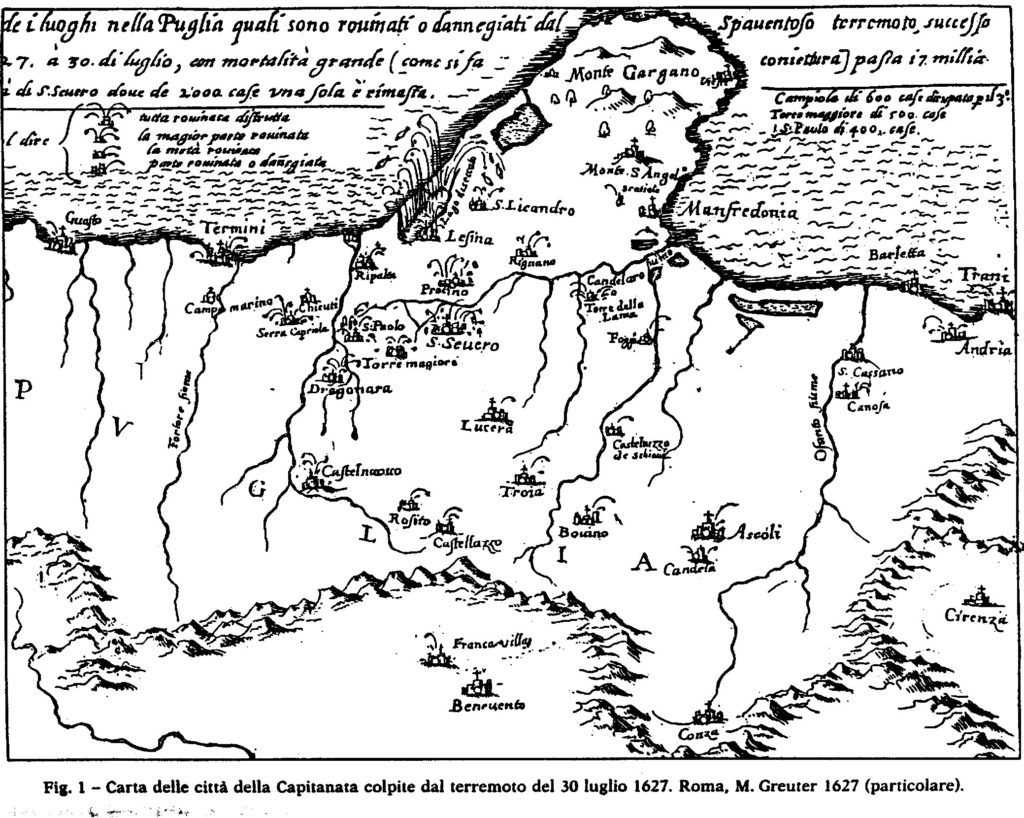
The Provincial of the Cappuccini Friars wrote to his head in Naples, describing the general destruction.
Reverend Father …
cited in Giovanni Antonio Foglia, Histórico Discorso del Gran Terremoto Ruino’ La Città di San Severo e Terre Convicine
It seems to me proper to send news to your Eminence of the heartbreaking events which occurred here on 30 July due to the earthquake in various parts of our province. San Severo, city of a thousand hearths, is completely destroyed. There is nothing left of Torremaggiore, a town that had four hundred hearths. San Paolo Casale of two hundred hearths, is also ruined … Serra Capriola, a most beautiful place, is in a most piteous state. Formerly of a thousand hearths not more than two hundred people remain alive. Of Lesina there is not a trace. … The sea of the riviera of Fortore have retreated more than two miles. A foul sulfurous smell rises from the Earth. …
In all this one earthquake killed 5000 people.
The Earthquake of Messina 1908
The earthquake of 1627 although called “great” was truly a “babe in swaddling” compared to many that have struck Italy and especially in comparison to the destruction that was visited on the city of Messina in 1908.
This time the earthquake struck in the early hours of the morning. The highest estimates say 200,000 people lost their lives. Little remained of the city of Messina. The destruction was so complete, that it was only the protests of the surviving citizens, that prevented the city being moved to an entirely new location. As in the earthquake of 1627, an accompanying tsunami devastated the sea shore in a wide distance around the epicentre, striking both Sicily and Reggio Calabria. This particular earthquake is among the world’s ten deadliest earthquakes recorded by history.

The journalist and novelist Jay Henry Mowbray tells the story.
All nature seemed at rest and at peace.
Suddenly out of the skies came a sinister hiss …
Crash! Bang!
The heavens thundered as from the bursting of ten thousand bombs.
The hiss deepened till it seemed that a myriad of red hot serpents were writhing in the waters.
Then came the whirl, the rush and roar of a torrential rain so terrifying that not a face but blanched with apprehension. …
The earth began to pulsate. Slowly and in rhythmic measure at first as though trying its strength and then with a wild and frenzied burst like the dance of a million imps. It rocked not only Messina, but half of Sicily and all of Calabria like a raft in a storm.
It lasted but an instant, but in that brief span scores of thousands perished ‘neath the ruins of the stricken city.
The first crash from the heavens reached every ear in Messina.
The houses had begun to vomit terror-stricken men, women and children before even the fantastic dance of earth began. …
Thousands gained the open streets before the final crash came. Walls fell to the right of them; roofs crashed to the left of them; cornices and chimneys toppled before them, while death stalked in their wake to destroy any who hesitated or paused. Other countless thousands were too late or were held prisoners of jammed doors and fallen stairways.
The earth shook itself in one great convulsive movement as though the giant whom tradition says Jupiter ages ago imprisoned beneath the massive rocks of Etna was struggling, after centuries of confinement, to break his bonds …
Even all of those who had sought safety in the streets did not escape. In many of the narrower thoroughfares the debris piled many feet deep from curb to curb, burying under countless tons of stone and mortar not only those who in their terror had taken shelter in their shadows, but the fleeing hordes who, maddened by the terror of that awful moment, had sought safety in flight. …
… The story of slaughter was not yet half told. Another, and, it might almost be said, even greater calamity, was impending.
There, in the open places, in the rain, bleeding from their wounds, nursing their hurts, the refugees huddled, praying for the coming of the day. …
In the growing brightness of the dawn they saw what yet was hidden from those lower down along the water’s edge.
Rearing its head fifty feet in the air a giant wave was racing from the Calabrian shore. They did not know, could not know, that already this same wave, first sweeping to the eastward, had engulfed Reggio di Calabria, a city of 50,000 people, eight miles to the southeast on the Italian mainland, across the Straits of Messina and that rebounding from the Calabrian cliffs it was returning to wreak a further vengeance on
stricken Messina.Those to the north, beyond the end of the breakwater, saw it almost as soon as the survivors in the forts.
In an instant there was a wild rush for safety, … the hissing wave, speeding along with the fleetness of a race-horse was upon them. …
The wave, 50 feet high, rolled back three blocks from the shore line and in its waters thousands met that death they had so miraculously escaped in the vortex of falling walls and crashing masonry.Hundreds of half-dressed men, women and children who had fled from their houses to the streets were caught in the onrush of waters and drowned or injured.
In a moment it had receded, carrying with it many of its unhappy victims, while the bodies of hundreds of others strewed the strand.
Jay Henry Mowbray
Rebuilding
That the names of each of the cities and towns mentioned in this article are still found on the map of Italy today is testament to determination of the survivors to rebuild their homes and communities.
San Nicola, Torremaggiore’s mother church had been destroyed when the 1627 earthquake struck. Within four years, as a plaque placed on the church solemnly proclaims, the survivors of the 1627 earthquake had rebuilt it.
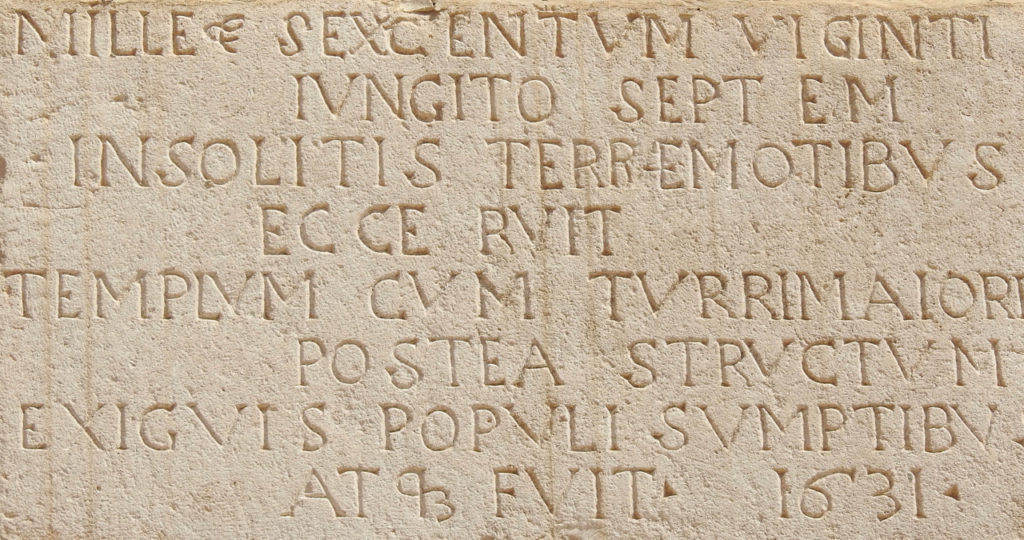
In one thousand six hundred and twenty seven an extraordinary earthquake destroyed Torremaggiore together with this temple, then rebuilt with the modest means of the people in 1631.
As in Messina, life and community would continue.
Sources
E. Patacca & P. Scandone, The 1627 Gargano Earthquake (Southern Italy): Identification and Characterization of the Causative Fault. Journal of Seismology. Vol 8: 259-273. 2004 Klewer Academic Publishers.
Giovanni Antonio Foglia, Histórico Discorso del Gran Terremoto successo nel Regno di Napoli, Nella Provincia di Capitanata di Puglia, nel corrente anno 1627, a di 30 di Luglio a hore sedici
Antonio Lucchino, Del Terremoto Che Addi’ 30 Luglio 1627 Ruino’ La Città di San Severo e Terre Convicine (cronache inedita di 1630) A Cura di Nicola Cecchia, Foggia Luigi Cappetta – Editore 1808, pp 10 et seq.
Jay Henry Mowbray, Italy’s Great Horror of Earthquake and Tidal Wave, 1909
